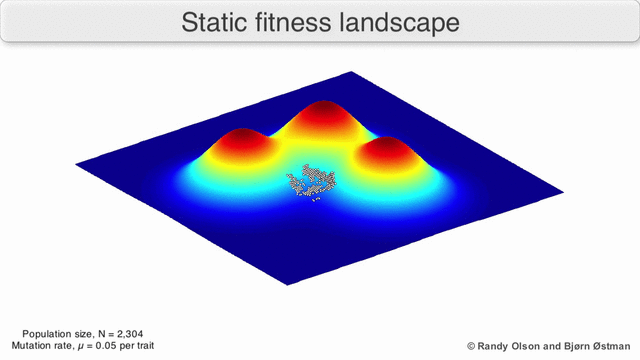This is a program I initially wrote for a BIOL 111 project. It visualizes the process of natural selection & evolution.
I must admit, I am not a biologist! This is a fun visualization, but I do not make any claims about realism.
This visualisation uses color to represent an arbitrary trait. When you click start, watch as the population's colors evolve!
First, choose your settings:
- Population Size: The max number of individuals in your population.
- Death Cutoff: Any individuals with a fitness below this cutoff will sadly pass away.
- Max Generations: The maximum number of generations to run this for.
- Display Every: Display every n generations.
- Optimal Color: This represents the color the fitness score will be based on.
- Mutation Rate: The chance a mutation will occur where 0 is no chance and 1 is certain.
Next, click start.
The algorithm will then generate an initial population, followed by each consecutive generation.
This algorithm works by repeating a series of steps.
First, it must generate a random population. It does this by generating random colors for each individual in the population and then calculating fitness scores for them (described below).
Each following generation is created with these steps:
- Selection
- Crossover
- Mutation
- Death
The fitness function uses the DeltaE library to quantify color differences. Once the color difference is calculated, I subtract it from 100 to create the fitness.
I could have used Euclidean distance, but the DeltaE library quantifies color difference based on human vision. Read more here.
This means two very dark colours with wildly different hues would be considered similar. Using Euclidean distance, these colors would be considered different.
Was this a good choice? I initially chose to do it this way because I intended to make a visual demonstration, so it would make sense to quantify visual differences only.
However, now I realize it means populations have multiple valid colors they could "adapt to".
For example, if the optimal color is very dark, the final population could be potentially any hue.
This is similar to fitness landscapes!
In this GIF, you can see how the population has many high-fitness peaks that it could adapt towards.
The selection function pairs individuals together to mate. They are paired randomly, but weighted by fitness.
This creates a mating bias for more fit individuals. This is the only desired bias in the webapp, and it is the bias that drives natural selection.
This step combines the color values together. It does this by concatenating the RGB values, choosing a random crossover point, switching the values at this point, and then turning it back into it's RGB values.
For example:
- {R: 155, G: 42, B: 255} and {R:255, G:120, B: 33}
- "155042255" and "255120033"
- "1550 42255" and "2551 20033"
- "155020033"
- {R: 155, G: 020, B: 033}
Ahh, the beauty of nature. I could cry.
Mutations will add or subtract a random amount from one of the RGB values. This amount is typically small, but can be larger.
Mutations do not always occur.
Death removes all who are not sufficiently fit. You can adjust this cutoff in the settings!
No. This is a very simplified model.
Here are some ways this isn't realistic:
- Fixed population size.
- Populations evolve towards a fixed goal.
- Lacks concepts of family or gender.
This is a cool, working visualisation, but it is not true reality.
These are things I intend to fix or implement
- Nothing right now. Feel free to send me ideas!


